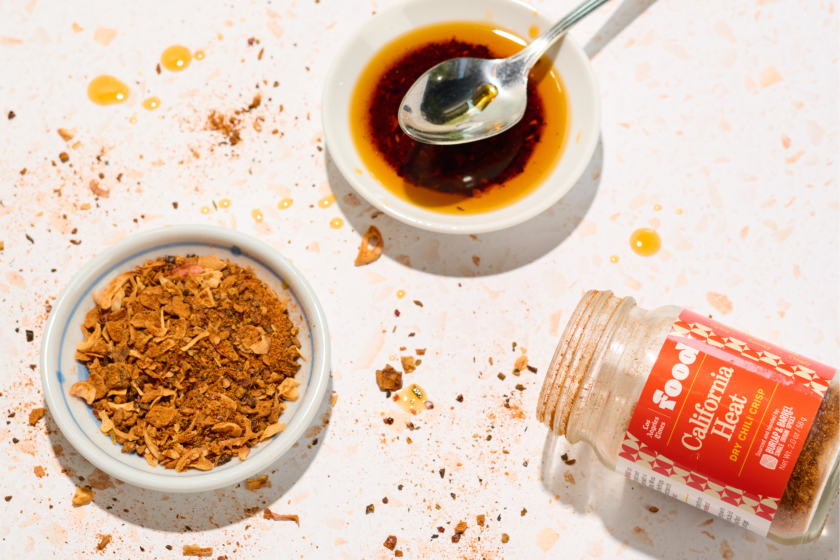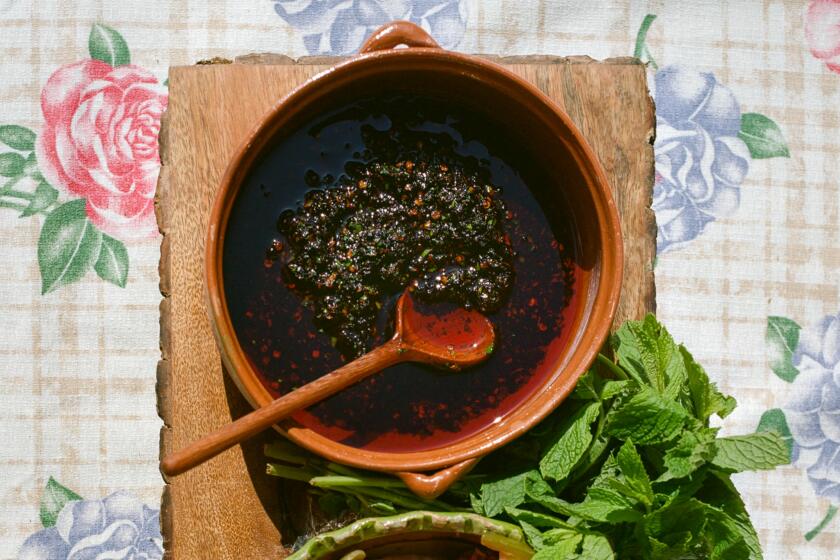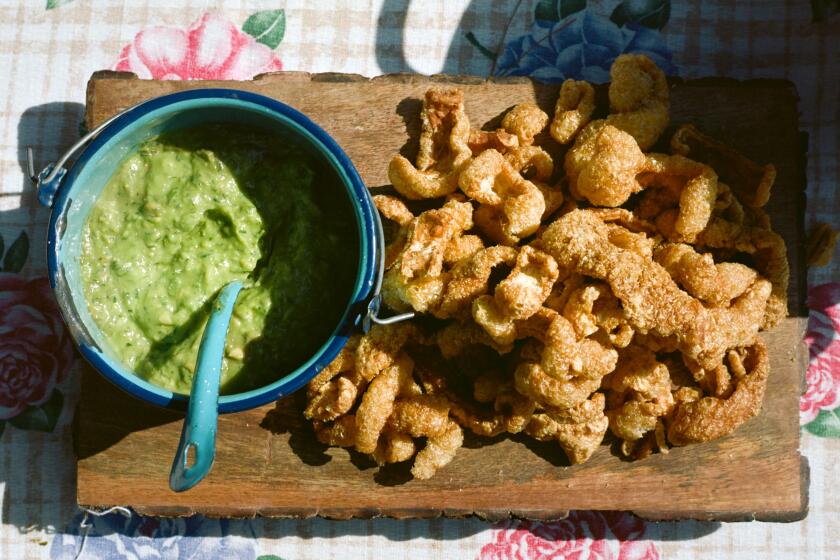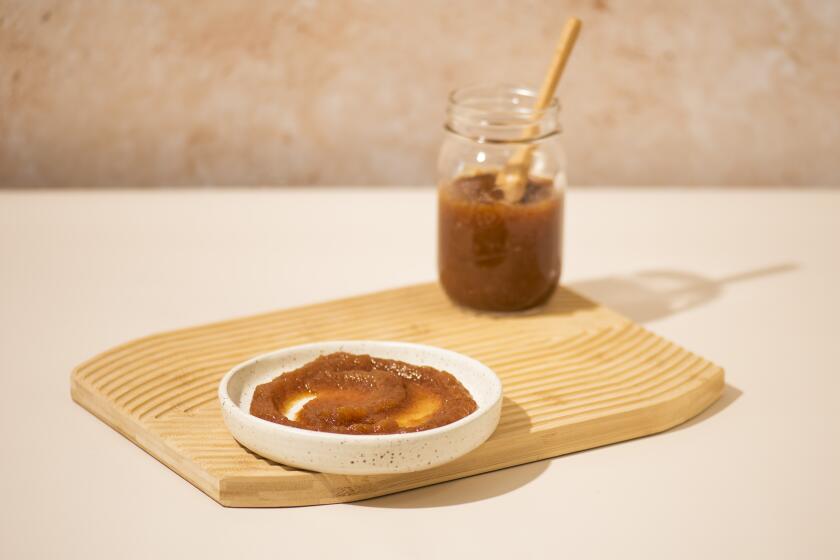Honey-brandy ice cream with fig jam

- Share via
Lots of foods are good. Only one is the product of nature aiming for irresistibility. Honey is food as seduction, nourishment and variety. There are, quite simply, almost as many types of honey as there are flowers.
Put bees on lavender, and the piercing perfume will permeate the honey. Meanwhile, avocado blossoms produce honey that’s mysterious, musky and strong. Chestnut honey is almost savory, so much so that it’s better served with pate and cheese than spooned into cream. Almond honey is just plain bitter, and farmers leave it to the bees.
Then there are the delicate surprises. California black sage, perhaps the most aromatic plant of the West, produces the subtlest honey imaginable. Meanwhile, honey melted off beeswax casings is so strong it could pass as molasses, and is perfect for beef marinades. One thing is clear: Honey is not so much a food as a school of foods. There is no one texture, color or taste.
But perhaps the most striking thing is how little humans have interfered with it. Although our animal breeders have changed the shape of cows, our agronomists have bred corn to the point where we can’t be sure of its wild ancestry, and our food processors have turned cheese into something that can be sprayed from a can, the main change in honey is that, thanks to an 1850 invention of a retractable bee frame, we can extract it from hives without killing the bees.
If you bought a jar of standardized Sue Bee clover honey, put it in a time machine and beamed it back to a cave man, the only thing that would confound him would be the vacuum packing and screw top lid. The honey he would recognize.
It is one of the last truly wild foods that pass the lips of most Americans. Even the most common supermarket blends still have a distinct gamy tang, a complex register of flavors and a host of nutrients nowhere to be found in sugar.
Think about it, and of course honey would have to be more interesting, more resilient than almost any other food. Ever since plant life extended beyond swamps and conifers, our diet has depended on it. We owe our existence to flowering plants. They owe theirs to honey.
Plants that need bees to pollinate them developed nectar as bait. They not only came up with the most compelling concoction possible for bees to drink, the plants also devised signage to direct them to it. The colored stripes on the corollas of, say, a violet, may look like decoration to us, but the botanical term for them is “honey guide” and the setting the “honey pad.”
The arrangement was so successful that lots of fruits and nuts began to grow, followed by warmblooded mammals like us. Today, apiarists at Cornell University estimate that one-third of the food we consume comes from crops pollinated by bees.
Exactly when we moved from eating plants pollinated by bees to raiding beehives for honey isn’t clear. But somewhere along the line, we figured out that bees consume enough nectar and protein-rich pollen to keep airborne, but their main purpose is to ferry it back to their hives to store for intemperate months, and to feed their young.
At the hive, the nectar is whisked inside and fanned by bees with their wings until enough water evaporates so that it won’t ferment or spoil. The bees then promptly seal the concentrated nectar, now honey, in protective wax combs. The finished product is imperishable. It may darken with age, or crystallize around a speck of dust or pollen, in which case a moment in the microwave will reliquefy it. But unless it’s watered down, it won’t spoil. The only safety concern is for infants, who should not be given honey until after they are a year old, when their immune systems are complete.
In her galloping read, “Food in History,” Reay Tannahill suspects that humans began beekeeping in central Asia. The universality of the Eurasian words for it -- Sanskrit madhu, Chinese myit, Slavic medhu, English mead, French miel -- all say pastoral herders to her. From thence, it’s a respectable guess that Turkish traders spread throughout the Middle East, where honey and fruit connoisseurship had been well established since antiquity.
Beginning in the 16th century, just as Europeans brought honey bees to America, trade in Caribbean sugar cane and a swelling slave trade introduced the world to another sweetener: sugar.
A gamy complexity
This set the scene for an uneasy relationship with honey and a defection of gourmands to sugar. While refined sugar became the choice of the elite in Europe and America, wild honey was dismissed as folksy, at best to be spread across a slice of hot buttered toast. At its worst, it became the emblem of the health food movement. It had such image problems that the current editor of Gourmet once devoted a column in this newspaper to how much she loathed it.
Science now is confirming that honey is better nutritionally than sugar. Phyto nutrients, antioxidants, much of human evolution behind it, one would have thought this obvious. The trick for cooks with palates trained on sugar and its one-dimensional sweetness is learning to handle the gamy complexity of the timeless food. For example, consider how well honey’s spice sits in tea, but how it’s deeply objectionable in coffee.
Even when honey is exactly what you want, there can be an unpredictable range of flavors within certain honey varietals. Expect them and taste for them. When Edon Waycott, a superb cook and for years the jam maker for Campanile restaurant in Los Angeles, devised an orange blossom baklava for us, we found orange blossom honey could be intensely floral, a veritable grove in a jar, or so mild it almost was indistinguishable from clover honey.
This is because, under federal standards, you need only as much orange blossom honey as you do votes to recall a California governor: 51% will do it. The milder honeys are blends; the more perfumed ones the more pure.
The tradition of blending honey isn’t to deceive, explains UC Davis apiarist Eric Mussen. It’s to create a consistent product. Un-blended varietals vary dramatically from batch to batch. Supermarkets and many customers won’t accept this.
To find pure varietal honey, replete with its ups and downs, one must look elsewhere. Go to www.honeylocator.com, and you’ll be directed to sources for honey made from apple blossoms, Hawaiian Christmas berries, huckleberries, tupelo and thyme.
Or, better yet, go to your local farmers market. Bill Lewis, an aerospace engineer turned beekeeper in the Angeles National Forest, takes his sage, citrus and wildflower honey to markets in South Pasadena on Thursdays and Montrose on Sundays.
He works with whatever’s flowering in southern and central California. When black sage is in bloom, the bees produce a uniquely delicate sage honey. Other times they browse on sumac and buckwheat. “When I don’t know where they’ve been foraging, I call it wildflower,” he says.
Unlike store-bought honey, Lewis’ is cloudy. In the packing room behind his house in Lakeview Terrace, he shows how the honey is spun from frames, filtered to remove pollen grains and grit, and bottled. That’s it. To filter it, small-time beekeepers warm it to hive heat, 90 degrees or hot enough to liquefy it, but they will resist going too much hotter because it creates a caramelized flavor and darkens the color.
He estimates that there are as many as 300 to 400 small-time beekeepers in Southern California. But many are so busy with their bees, they don’t bottle. This is where packers come in, such as 109-year-old Miller’s Honey in Colton.
Miller’s used to keep bees too, explains Marketing Director Merrill Paxman. Now it just blends, packs and sells. It will take shipments as large as a tanker truck or as small as a single 55-gallon barrel. Inside, labeled jars, samples from each delivery, run from apple blossom white to a dark molasses brown. “Each batch is checked for flavor, color and moisture content,” Paxman explains.
Miller’s heats the honey it receives to about 130 degrees. Then they blend it so customers, which include Stater Bros. and Whole Foods, get a consistent product week after week.
A local beekeeper shows up in Miller’s office, looking to charge a pair of beehandling gloves against a delivery of four barrels of honey. His name is Steve Estes, he’s as toothless as Chris Cooper in “Adaptation,” a loner just in from the desert and about to return to it. He used to work as a painter, he says, but beekeeping gives him independence. He and his father have had their 300 hives on tamarack trees around Indio. After a disastrous time last year, with drought and mites, this year has been good. Prices have improved since the Food and Drug Administration staunched the flow of contaminated Chinese honey and rains have been adequate. There are flowers for the bees to work.
“The fall bloom is looking real good,” he says. “If fall bloom is good, we’ll go into almonds looking real good.” By spring, he’ll need to divide his hives before moving onto the citrus crops.
Paxman smiles. According to him, Miller’s founder, Nephi Miller, a Utah Mormon, invented itinerant beekeeping and following the crops after bringing his hives from northern winters to forage on Southern California chaparral. Food historians think it probably happened a bit earlier, and to the east in ancient Mesopotamia.
Either way, it hasn’t changed much. You take bees to the blossoms, and they do the rest.
Fig jam
Cut the tough ends off the fig stems. . Quarter the figs and place in a medium saucepan with the sugar, lemon zest, salt and water. Bring to a simmer and cook for 10 minutes, until the figs are soft and translucent.
Puree the mixture by passing it through a food mill and return it to the saucepan. Cook over low heat until it is a very thick paste, about 15 minutes.
Honey-brandy ice cream
Heat the milk and whipping cream together in a large saucepan until scalding but not boiling. Remove from heat.
Stir a little of the hot milk into the beaten eggs then return the mixture to the pan. Cook over low heat, stirring constantly, until the custard thickens slightly. Do not boil.
Remove the custard from the heat and stir in the honey until blended, then add the brandy. Pour the mixture through a fine-mesh strainer to remove any lumps.
Chill in the refrigerator several hours or overnight, then freeze in an ice cream maker according to manufacturer’s directions. This ice cream tastes best served right from the ice cream maker, topped with a spoon of fig jam. Otherwise, spoon the ice cream into a chilled glass bowl and cover before freezing. Remove from the freezer to temper 10 to 15 minutes before serving.
Get our Cooking newsletter
Get a taste of Los Angeles — and the world — with recipes and kitchen tricks from the L.A. Times’ Cooking newsletter.
You may occasionally receive promotional content from the Los Angeles Times.















